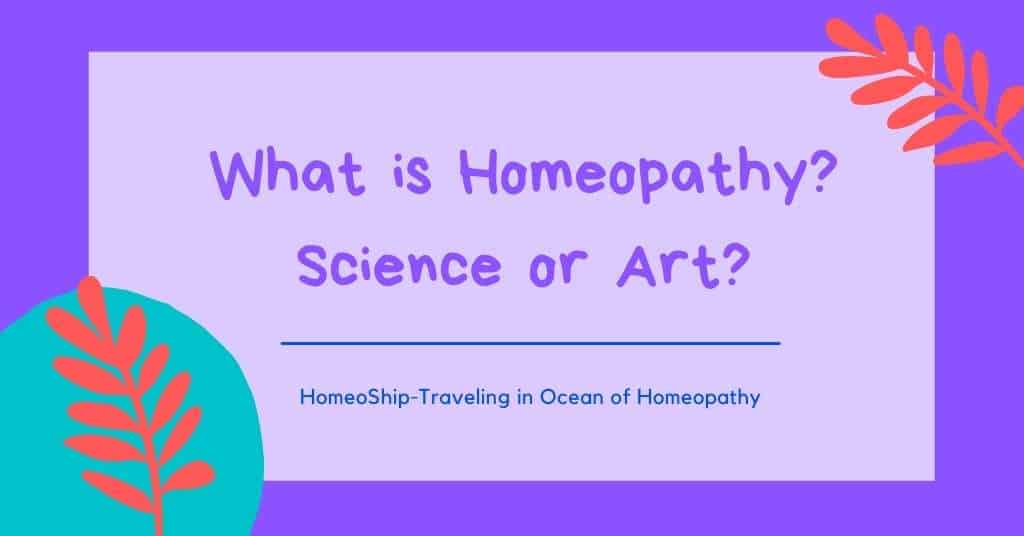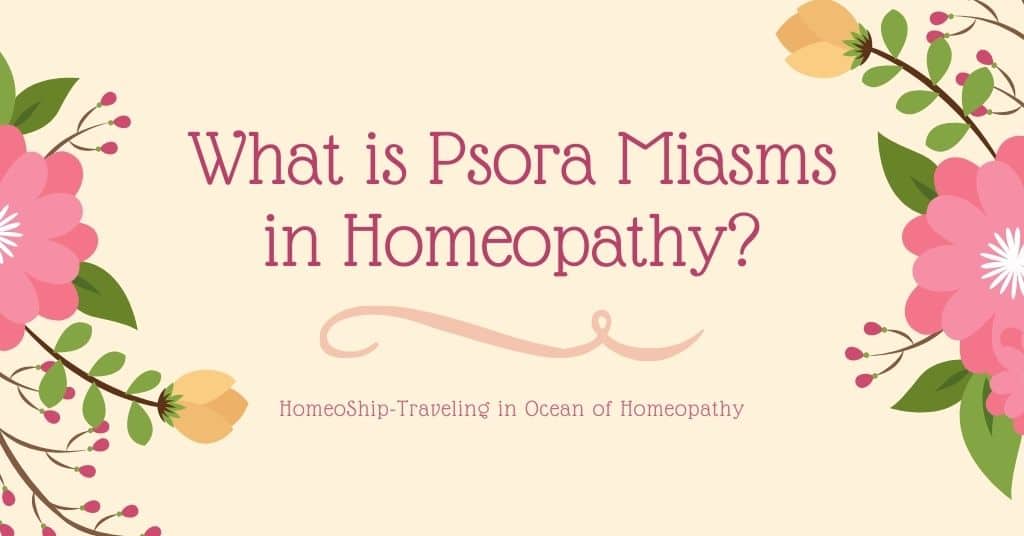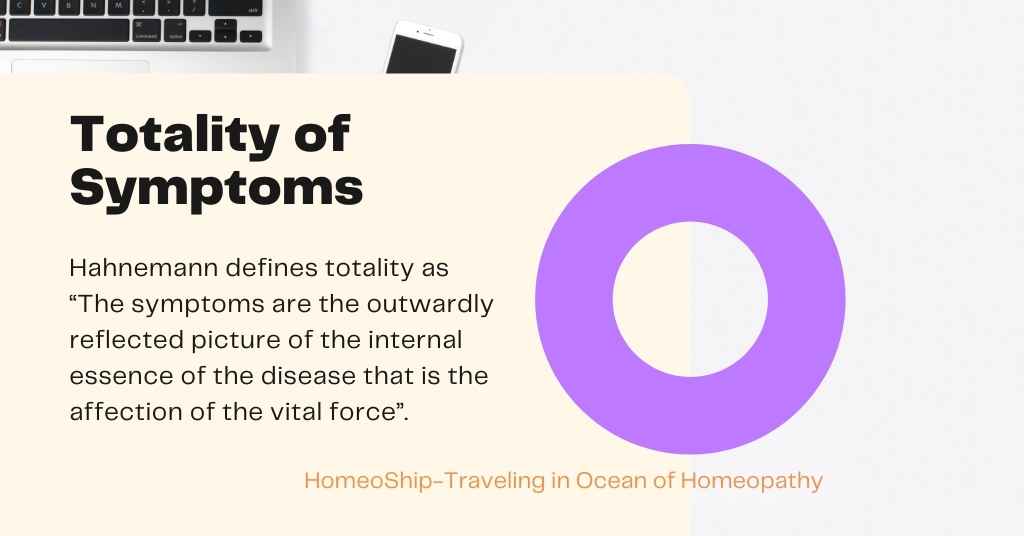Homeopathy is both science and art. A successful homeopath artistically applies the fundamental homeopathic laws into his practice. A medical student trains himself in science and applies it as an art in his practice.
“Science teaches us to work; science is a theory, art teaches us to do: art is practice. Every art has its foundation in science. Every science finds its expression in art. Consciously or unconsciously, the artist at work is applying principles and laws, formulated and systemized knowledge of which constitutes science. An integral development of personality is achieved when the artist becomes scientist and the scientist becomes an artist” – Stuart Close.
The Scientific Aspect of Homeopathy

1. Discovery of Homeopathy: The birth of homeopathy is strongly rooted in the scientific experimental episode “Cinchona bark experiment of Hahnemann”. “Cinchona bark was to Hahnemann what falling apple was to Newton and swinging lamp was to Galileo”. Science believes in observable facts that can be verified by anybody. Hahnemann did not only confirm the action of cinchona bark on himself but also on a number of provers. Thus, he proved successfully that the cinchona bark can cure malaria not because it is bitter in taste but because it produces malaria-like symptoms in healthy human beings.
2. Historical Considerations: The law of similia was not newly invented by Hahnemann but previous experiences of clinicians of the past like Hippocrates, Paracelsus, Stahl, etc., had confirmed the efficacy of the law of similia in curing the disease. Hahnemann has stated in many instances the examples of similar, stronger diseases removing the weaker similar diseases in nature. He supported his theory with the examples of different medical personalities and their literary works.
3. Homeopathy Based on the Inductive Logic: Inductive logic is also called scientific or objective logic. Every science follows this method of induction. The four steps of induction are
- Exact observation
- Correct interpretation
- Rational explanation
- Scientific construction
Based on these premises, science is deriving its general laws based on its particular experiments. So, if we consider the experiments of Hahnemann on different individuals as the particular premises, and the construction of the law “similia similibus curentur” as the general conclusion, we can clearly state that homeopathy is based on the inductive method of logic.
4. Healthy Human Drug Proving: Albrecht von Haller and others have identified the importance of human drug proving but, Hahnemann the medical genius made this practically possible. The homeopathic materia medica is not a theoretical fancy; it is the systematical recording of the experimental findings of the drug actions on healthy human beings. Hence homeopathic materia medica can also be called the human functional pathology. If science believes in the experimental facts, then the homeopathic materia medica is the proof of such experimental facts, hence it is a science.
5. Homeopathic Law and Its Scientific Truth: Science is respected as knowledge because it is dealing with the universal truth. Its aim is to find out the ultimate truth, it is always associated with reality. The homeopathic therapeutic law is based on nature’s law of cure. Nature’s law is the eternal law it was invented by nobody but verified by everybody. Homeopathic law is the practical application of the universal principle of multi-action formulated by Isaac Newton and his third law of motion “action and reaction are equal and opposite”. Science is an attempt to explain natural phenomena; it revolves around natural laws and their explanations.
“The homeopathic superstructure has been raised on solid concrete, composed of broken rock of hard rocks, united by the cement of a great natural principle”– Stuart Close.
Homeopathic therapeutic law is the derivation of the eternal law of nature, hence is purely scientific.
6. Homeopathy and its Literary Treasure: Science always insists on theories, so that the facts and findings can be explained to the next generations and for further verifications. Organon of medicine provides systematized training to the aspiring homeopath. The do’s and don’ts of the homeopathic practice and guidelines for further verifications of the drug proving methodologies etc are clearly demarcated in this text by Hahnemann.
In the later years, pioneers of homeopathy have further improved this part by their valuable literary contributions. Boenninghausen, Kent, Boericke, Hering, Allen, Burnett, M.L.Tyler, Nash, Dunham, Richard Hughes, Dudgeon, etc have extended their remarkable contributions to homeopathic literature. A wide range of repertories, homeopathic pharmacopeias, and different varieties of books on materia medica is presently available to educate aspiring homeopaths.
7. Clearly Defined Scope and limitations: “Science is captured territory” says will Durant. There are certain phenomenons in nature that are still out of the reach of scientific explanations. Science always seems to progress in the name of progress, but still, there are limitations to science also and homeopathy is not an exception; it has its own scope and limitations. The trained and educated homeopath can easily define the scope and limitation of homeopathy. Hahnemann has clearly defined the scope of homeopathy in dynamic diseases only.
In § 13 he states, “therefore in diseases (that doesn’t come within the province of manual surgery)” homeopathy is applicable. Footnote to § 67 is the example of the scope and limitations of homeopathy, where Hahnemann mentions that only in conditions where the vital force is active homeopathy can bring about a cure. Hence, he recommends the antipathic palliative modes in life-threatening conditions and in conditions where vital force is debilitated. Stuart Close has made it more clear that in the conditions resulting from the mechanical trauma, and in chemical poisonings, dynamic homeopathic medicines have no role to play.
But in dynamic diseases, homeopathic law is the only curative. 8. Homeopathic Principles and Experimental Proofs: Homeopathic principles like drug dynamization and vital force have been ridiculed by the dominant medical school for centuries. But this school has forgotten that the systemic study is not just the study of the material aspect of any subject but its spiritual aspect also.

The existing science can accept only those facts which can be verified in the laboratory, but it is the limitation of existing science. Even the well-trained biologist cannot deny the existence of a life force in the living body, though he cannot directly show its presence in it. So many attempts have been made to explain the presence of energy in potentized medicine:
i. Wannamaker of the U.S.A. conducted experiments to prove the efficacy of highly dynamized Sulphur on onion plants. He planted seedlings obtained from the commercial grower in large trays as 96 seedlings for each tray. Then he added 12x, 24x, 30c, 60x, and 20M Sulphur dilutions to these trays. He kept some more trays as control studies. Those seedlings treated with the micro dilutions produced onion bulbs and seedlings much weightier than the untreated ones. There Ca, Mg, K, and Na contents were also richer in comparison with the control trays. Is this a placebo effect?
ii. One of the oldest laws of pharmacology the Arndt-Schulz law (1888) advocates “for every substance, small doses stimulate, moderate doses inhibit, large doses abolish”. Dr. Boyd’s experiment on the action of microdoses of Mercuric chloride on malt diastase is based on this law. It is already known to the chemists that crude Mercuric chloride inhibits the diastase activity.
But Boyd’s experiments (1916) showed that Mercuric chloride 61x accelerated the diastase activity instead of inhibiting it. To avoid any amount of confusion he also kept a controlled study with distilled water. Distilled water did not show any amount of reaction with the Mercuric chloride. Boyd’s conclusion was if the mercuric chloride 61x did not have any amount of reactive capacity, it should have shown a result similar to that of the distilled water.
iii. Dr.W.J.Boyd further demonstrated conclusively the presence of some energy in the potentized medicines which he detected with the needle of a sensitive galvanometer, the Emanometer. On the basis of the findings of the Emanometer, he tried to classify the medicines of materia medica into ten groups.
iv. Law of similia is not new to Allopaths also. It is widely practiced by them even today. Example: Streptokinase (Fibrinolysin) is a toxin produced by the pathogenetic bacteria Str. Pyogenes. “Fibrinolysin appears to play a biological role in streptococcal infections by breaking down the fibrin barrier around the lesions and facilitating the spread of infection. Streptokinase is given intravenously for the treatment of early myocardial infection and other thromboembolic disorders”. If it produces it cures. Homeopathy isn’t it?
v. French physicist Gustave de Bon demonstrated that Sodium chloride 1M potency, when sprayed into vacuum produced ‘sodium spectrum’. How does this happen when the 1M potency of Sodium chloride does not possess any imprint on it. Is it a placebo effect?
vi. Homeopathic supporters all over the world are trying to create a workable model to explain the modus operandi of homeopathic cure. “Storage of vibratory energy” is one of such theories which gives some hope to the modus operandi of homeopathic cure. It explains that during the collision process, vibratory energy is exchanged between the source drug and the water, and the water is left with a vibratory imprint of the drug.
Further succussion deepens the imprint of the drug. In another experiment, different potencies of Pulsatilla were frozen at -100ºC and photographed under polarized light to see any difference. The results were strikingly in support of homeopathy. Each potency had shown different crystal sizes as the potency increased indicating the increased energy storage in vibratory modes.
vii. Another proof came in support of homeopathy from Professor Jacques Benveniste, principle experimenter of the French medical research council. This experiment was published in the “Nature 33; P816 30 June (1988)”. When basophils are exposed to antibody IgE, their chemistry and structure will change. This is a demonstrable serological test.
But, according to the experiments of Benveniste and his fellow members even the highly diluted dynamized antibody IgE 120x potency was effective against bringing changes in the basophil. This was an astonishing truth to many scientists. The deputy editor of “Nature” remarked that the existing biological laws have to be abandoned if this is true.
viii. M.L.Tyler in her book “Homeopathic Drug Pictures” had explained curie’s experiments with Drosera. Curie has successfully proved that prolonged administration of the drug Drosera caused tuberculisation in cats. Cats were chosen in the experiment because cats are known to be the least liable to tuberculosis. Curie further stated that the Drosera’s power to cause tuberculisation had helped him in prescribing Drosera successfully in treating tubercular cases.
ix. The “bio-photonics” (a science that deals with the kind of radiation emitted by the living body), and the “Kirlian photography” has proved the existence of life force in the living body, which can be demonstrated by specialized photographic techniques. They have proved by these techniques that the radiation levels changes from one person to another and moreover the intensity of radiation differs from the healthy person to the sick. This is a shred of strong evidence for the doctrine of vital force.
x. Stuart Close in his “Genius of homeopathy” explains that “Homeopathy rests upon the following general interpretations of nature, which even the existing science recognizes:
a. The laws of nature are uniform and harmonious
b. Effects follow causes in unbroken succession
c. To every action, there is the equal and opposite reaction
d. Action and reaction are ceaseless, equivalent, and reciprocal
e. Motion is ceaseless and transformations continuous
f. The matter is indestructible and infinitely divisible
g. Force is persistent and indestructible
h. The quantity of action necessary to effect any change in nature is least possible. Homeopathy as an Art Hahnemann called the medical practice the “Art of healing”.
Mere experimentations do not cure the patient. The failure of modern medicine in the so-called allergies and auto-immune disorders is the best example of this. Even modern science explains therapeutics as the artistic application of medical science in order to treat the patient. Individual skill is required at every step of treating the patient. Homeopathy is the specialized system of medicine that demands individual interest and artistic skill on the part of the physician.
The history of homeopathy and the way its pioneers practiced homeopathy it clear that the more conscientiously the physician approaches homeopathy, the better will be the clinical results.
1. The process of acquiring the peculiar, uncommon, individual, characteristic symptoms of the patient is the key to top successful homeopathic practice. This demands intellectual alertness on the physician’s side during case taking. Caretaking is no doubt an artistic process in any system of medical practice whereas in a homeopathic system even experts will not find the similimum when the case is incomplete and inaccurately sketched.
But even a beginner can find the similimum when the case is well taken and contains the individualistic characteristic symptoms indicative of the medicine. Analyzing the case and finding out the exact cause of the disease, whether it is somatic or psychic in nature, and finding out the exciting cause and the maintaining or fundamental cause is also a skill.
2. Evaluating the symptoms according to their importance for homeopathic prescription is no doubt an art. Based on the symptoms available and his judgmental unprejudiced approach, the physician evaluates the symptoms. Based on the symptom’s nature he selects the suitable repertory for finding the similimum. But the selection of the remedy is not a mathematical deduction in homeopathy; hence among the group of medicines, repertory indicates the final remedy is selected only by the physician.
3. Homeopathy works in harmony with other branches of medicine like surgery, obstetrics, hygiene, dietetics, psychotherapy, etc. Hahnemann also recommends the artistic use of therapeutic methods other than drugs like mesmerism, galvanism, bath, magnetism, massage, etc. Where and when to make use of such procedures is only the duty of the physician.
4. The intelligent use of diet and regimen based on the nature of the disease is in the physician’s hands. Example: Changing the room temperature and arrangements according to the wish of the patient suffering from acute disease, encouraging the sedentary workers and intellectuals to do some physical activities, etc.
5. Selecting the potency and the repetition of the dose is purely a challenging task in homeopathic practice. Dr. Tyler says repetition of doses and selection of potency in homeopathic practice is like supplying electricity to electric gadgets. Proper voltage has to be supplied to the particular device or else we will lose the fuse or the device itself. Age, occupation, nature of the disease, stage of the disease, susceptibility always help the physician in the selection of the potency. There are no hardcore rules for the selection of potency; only the individual experience teaches the physician how to do it?
6. Remedy reaction, what happens after administering the suitable homeopathic medicine? Is purely an art. There are no devices found to identify whether the administered remedy is curative or not. Observing Hering’s law of cure is the only indication, and this observation is a skillful procedure. Hence homeopathy is both science and art. Successful application of the law of similia is a beautiful work of art.
Also Read:
- Samuel Hahnemann Biography & Rags to Riches (1755-1843)
- How Repetition of Doses works in Homeopathy?
- Does Homeopathic Miasms are Microorganisms?
Master Hahnemann says “Homeopathy solely appeals to the verdict of experience …..Repeat the experiment carefully and accurately and you will find the doctrine confirmed at every step….. Homeopathy insists on being judged by results”. We can conclude that the homeopathic system is constitutional drug therapeutics, challenging the artistic abilities of the prescriber.
“As a prerequisite to a clear understanding of the subject, as well as to the astonishment of efficacy in the practical application of its principles, it is assumed that homeopathy is what it is claimed to be, a complete system of therapeutic medication. As a scientific system it is made up of certain facts, laws, rules, and methods or process, each of which is an integral part of the whole”-Stuart Close.
“Homeopathy is not merely collection of few medicines but a new science with rational philosophy as its base. We require more scientific interest and inquiry into the matter with special stress upon Indian environment”– Nobel laurel Dr. Ravindranath Tagore.


